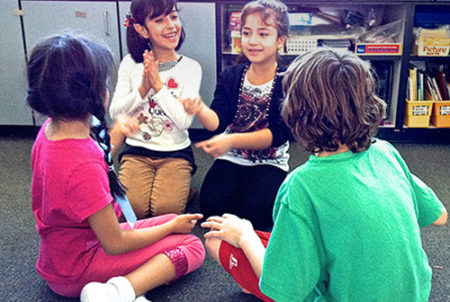David Coleman, primary author of the Common Core Standards, is very clear about how the arts help students access the Common Core requirements in English Language Arts and Math. The very skills that the arts have always taught are those at the center of the Common Core paradigm. These skills, sometimes known as “the four C’s” are: communication, collaboration, critical thinking and creativity.
 This year the Santa Cruz County Office of Education and Arts Council Santa Cruz County have been funding an exciting program in four schools in the Pajaro Valley Unified School District and one in the Live Oak School District called the Artist Teacher Partnership (ATP). The ATP is one of the follow-up programs for the immensely popular COE Summer Arts Institute.
This year the Santa Cruz County Office of Education and Arts Council Santa Cruz County have been funding an exciting program in four schools in the Pajaro Valley Unified School District and one in the Live Oak School District called the Artist Teacher Partnership (ATP). The ATP is one of the follow-up programs for the immensely popular COE Summer Arts Institute.
The ATP partners a classroom teacher with a SPECTRA artist and focuses on helping students learn the skills of the four C’s through hands-on involvement in one of the four disciplines of the arts. These skills can then be transferred to other areas of learning such as ELA and Math. In addition, there is a professional development component for both teachers and artists. Teachers are learning arts techniques from the artists and, supported by the COE coaching program, how to integrate these skills into their Common Core curriculum. Artists are learning the language of not only Common Core but also assessment in the arts so they can improve their teaching abilities in classrooms.
One 3rd grade teacher at Freedom Elementary is thrilled to see how the vocabulary of the many English learners in her class has expanded through the ATP dance program taught by SPECTRA artist Laurel Shastri. By ‘dancing’ prepositions and building a dance ‘word wall’ the students are able to articulate and communicate the meaning of the words in a way they had not been able to do before.
Fifth grade students at Landmark Elementary School had a wonderful experience with SPECTRA artist Jerry Falek learning how weaving can help them focus and begin to develop those critical thinking skills they need to tackle the new Common Core Standards, while creating a piece of art of which they can be proud.
At Amesti Elementary, the program was in three third grade classes as well as one first grade class. The focus was on dance and math. One of the third grade classroom teachers had this to say:
“Both the students and I learned that geometry, fractions and even multiplication facts could be demonstrated through creative movement. My students had to communicate and negotiate with one another, sometimes verbally, sometimes nonverbally. I learned so much as a general education teacher about tying elements of dance and artistic valuing into math. (The ATP project) was a fantastic way to practice mathematical concepts kinesthetically. For ELLs, this has been a wonderful way to incorporate vocabulary.”
In visual art, Ohlone Elementary 1st and 2nd graders also played with shape but this time they created shapes with paint while learning the magic of color mixing. From “tints” (using a white base) to “shades” (using a black base) the students explored the infinite possibilities of color within and around their shapes. Again the vocabulary enhanced their English Language Arts, while their creative ability shone in a vast array of original shapes and colors.
Ohlone 1st and 2nd graders learn about color mixing and shape
In the words of David Coleman:
“The great news is that the (Common Core) Standards call on so many things the arts do well. The tradition of careful observation, attention to evidence and artists’ choices, the love of taking an artist’s work seriously lies at the heart of these standards.”
—David Coleman, president of The College Board and primary author of the Common Core Standards
Common Core is here, and we have the arts to support us in this new educational world.
If you are a K-8 teacher who would like to explore how the arts support Common Core and ELD, please consider coming to the 2014 Summer Arts Institute June 23-27.
